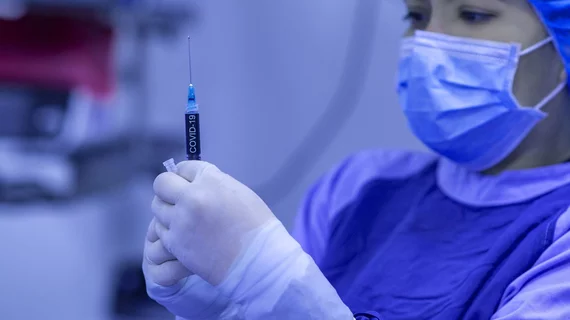Managing COVID-19 vaccine side effects: Harvard radiologists share their ‘pragmatic’ approach
Radiologists are reporting increasing cases of incidentally discovered enlarged lymph nodes on breast screening exams in people who have received their COVID-19 vaccine. This widely reported side effect can fool some doctors into a cancer diagnosis, with follow-up guidance recommending everything from biopsy to immediate ultrasound imaging.
A trio of Harvard Medical School radiologists on Tuesday, however, sought to help mitigate the impact of vaccinations during breast imaging by sharing their own approach. The “pragmatic” guidance is based on the American College of Radiology BI-RADS Atlas and aims to encourage vaccinations, ensure patients receive proper care and limit unnecessary testing.
“In this [breast cancer screening] setting, we believe our model can avoid reducing or delaying vaccinations and avoid further reduced or delayed breast cancer diagnoses based on confusion amongst patients and/or their providers,” Constance D. Lehman, MD, PhD, and colleagues with Harvard-affiliated Massachusetts General Hospital, explained in AJR.
At the Boston-based institution, Lehman et al. said they manage patients with incidental unilateral axillary adenopathy (lymph node changes on one side) based on an individual’s clinical presentation: asymptomatic for screening, symptomatic breast and/or axilla for diagnosis, or recent cancer diagnosis in the pre- or peri-phase of treatment. A technologist also documents vaccination status, first or second dose with corresponding dates, and the vaccination side and location.
During screening mammography or MRI, if providers only find enlarged lymph nodes on the patient’s vaccination side administered within the past six weeks, they report the adenopathy as benign. Follow-up imaging is not required if nodes aren’t tangible six weeks after the last dose.
In these cases, patients also receive a letter with lay language indicating their side effect is “common” after the vaccine and the body's “normal reaction.”
If the provider can feel enlarged lymph nodes on the vaccination side, clinical follow-up is recommended using BI-RADS 2 (benign). If concerns remain six weeks after the patient’s final dose, an axillary ultrasound is suggested.
Furthermore, Lehman and colleagues encourage prompt imaging and vaccination in patients recently diagnosed with breast cancer who present in the pre- or peri-treatment setting.
In each of the aforementioned situations, Harvard providers will recommend axillary ultrasound if concerns linger six weeks post-vaccination, they explained.
Adding vaccine information to imaging intake forms can help ensure patients are managed appropriately, the group noted. They added that their model should help streamline care as patients reschedule previously delayed screening exams and cancer procedures.
“As we navigate through this phase of the pandemic with vaccination programs expanding, and as more data become available, we will continue to refine our patient management paradigm to guide best practices for our patients,” the researchers concluded.
Read the entire clinical perspective in the American Journal of Roentgenology here. And for additional information on managing vaccine side effects click here and here.

